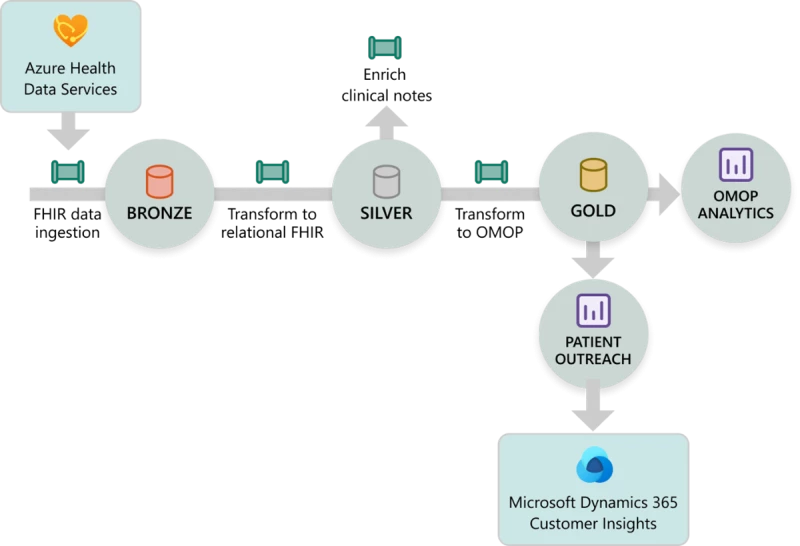
Unlock data value with healthcare data solutions in Microsoft Fabric
Our world is driven by data. With the right data management strategy, healthcare organizations can use data to gain insights into patient care, clinical decision-making, research, and operational efficiency.
As part of Microsoft Cloud for Healthcare today, we are announcing the preview of healthcare data solutions in Microsoft Fabric. This tailored offering enables healthcare organizations to break down data silos and harmonize their disparate healthcare data in a single unified store where analytics and AI workloads can operate at scale. Leveraging the native capabilities of the platform, health organizations can create connected experiences at each point of care, empower their workforce, and unlock value from clinical and operational data.
With Microsoft Cloud for Healthcare, your organization can accelerate time-to-value using healthcare data solutions in Microsoft Fabric to unify your data at every layer—one copy of data in the lake, one product experience for collaboration, governance, and unification of the business model to ensure resources are cost-optimized.
Get more value from your data
This preview delivers data solutions that leverage Microsoft Fabric Lakehouse architecture to support the ingestion, unification, harmonization, and transformation of multi-modal healthcare data from disparate sources. Combining data from previously siloed sources across their organization, such as electronic health records (EHRs), Picture Archiving and Communication Systems (PACS), labs systems, claims systems, and medical devices enables organizations to bring structured, unstructured, imaging, and medical device data into one common architecture.
The functionality in this preview consists of lakehouse foundations, with data ingestion mechanisms and analytical capabilities. Lakehouse architecture in Microsoft Fabric combines both data lakes and data warehouses, storing data in open delta-parquet format. This enables customers to run large-scale analytical scenarios in a cost-effective manner.
These healthcare data solutions provide full support for industry standards like Fast Healthcare Interoperability Resources (FHIR)®R4 and Observational Medical Outcomes Partnership (OMOP) analytics in the lakehouse. This unified data foundation in the Microsoft Fabric data lake will allow healthcare organizations to:
what is spark compute in microsoft fabric?
Learn more- Process, store, manage, and govern structured and unstructured data in a single, unified repository preserving complete data fidelity. With the ability to do delta-time travel, it ensures data consistency by way of providing data lineage and auditing.
- Structured query language (SQL) endpoints attached to each lakehouse simplify the ability to explore and interact with the data in bronze, silver, and gold lakehouses using SQL.
- Leverage Microsoft Fabric data engineering and data science capabilities to conduct data analysis and operationalize machine learning pipelines at scale using Python notebooks powered by Spark’s distributed computing capabilities.
- Preserve and analyze historical data to create longitudinal patient health records to conduct patient and population-level proactive and retrospective research studies.
- Build patient cohorts to proactively initiate patient outreach or conduct clinical research studies based on disease cohorts to guide clinical care pathways for patients.
Here are some of the capabilities being released in preview:
Fast Healthcare Interoperability Resources (FHIR) data ingestion. Enables easy ingestion of FHIR data from Azure Health Data Services in Microsoft Fabric Onelake environment and stores it in the bronze lakehouse as raw newline-delimited JavaScript object notation (NDJSON) files.
Relational FHIR data foundation enables the transformation of FHIR data in bronze to relational FHIR and tabular structure in open data format (delta-parquet) in Silver Lakehouse using highly scalable purpose-built pipelines. This creates a standard-based unified healthcare data model in Silver Data Lake. With support for all FHIR R4 resources, this now enables multiple downstream analytics support for scenarios leveraging the rich clinical, financial (claims and explanation of benefits), and administration data. Healthcare companies and partners can now build analytical scenarios such as quality reporting, population health management, clinical research studies, and operational reporting. It also allows a traditional SQL engine to run on top of the data for a data analyst to conduct ad-hoc exploratory analysis of the healthcare data.

What is Text Analytics for health?
Read moreEnrich unstructured clinical notes enables conversion of unstructured clinical notes to structured clinical data through purpose-built data pipelines leveraging the natural language processing (NLP) capabilities of Microsoft Azure Text Analytics for Health. It enriches a patient’s clinical profile with additional insights coming from handwritten physician’s notes in their interactions with a patient and captured in clinical notes. This data can then be analyzed to produce insights, analytics, prediction, or quality measures to improve patient health outcomes.
De-identifying clinical data for research and secondary uses enables health organizations to de-identify clinical data such that the resulting data retains its clinical relevance and distribution while also adhering to the Health Insurance Portability and Accountability Act (HIPAA) privacy rule. The service currently supports unstructured text and will soon cover various other data types (structured and imaging). The service uses state-of-the-art machine learning models to automatically extract, redact, or surrogate over 30 entities—including HIPAA’s 18 personal health identifiers (PHI)—from unstructured text such as clinical notes, messages, or clinical trial studies. The service also offers best practices for PHI protection in the form of surrogate replacement, where PHI elements are replaced with plausible-looking surrogates; resulting in data that is most representative of the source data.
Observational Medical Outcomes Partnership (OMOP) analytics enables clinical researchers to perform research and analysis using the standard OMOP v5.4 Common Data Model. Hydrate OMOP schema transforming the relational FHIR data in silver to OMOP datasets using purpose-built pipelines.
Once hydrated, users can use notebooks to build statistical models, population distribution studies and Power BI reports to visually compare different interventions and their effects on patient outcomes. Researchers can now quickly do ad-hoc analysis, using SQL or notebooks. Examples include tracking disease state progress over time, comparing procedures and drug exposures, or comparing drug exposures and condition occurrences.
Patient Outreach analytics enables segmentation in Microsoft Dynamics 365 Customer Insights with ease by ingestion of healthcare data in Silver Lake without requiring any custom transformation of heavily nested FHIR data. Now it is even easier for care providers to understand patients, create comprehensive segments, and enhance outreach communications, thus fostering the expansion of patient base and revenue streams at a swifter pace. Plans are also in the works to support bringing data from Dynamics 365 Customer Insights and Patient Outreach journey application templates to Microsoft Fabric, enabling unified marketing and clinical reporting.
Data governance with Microsoft Purview. Within our new healthcare data solutions (preview) in Microsoft Purview, healthcare organizations can better govern, protect, and manage their entire data estate by leveraging features like:
- Healthcare classification templates to categorize and classify data, based on predefined rules and patterns, to put for HIPAA-specified identifiers.
- Data glossary of FHIR entities provides a common data glossary across the organization reducing the potential for data misunderstanding and errors.
Explore possibilities with AI
Analytics-ready data available in a single data estate makes it easier to leverage the power of AI and machine learning. Today, we also announced new capabilities across Microsoft Azure to help healthcare organizations use AI and machine learning to derive insights to improve clinicians’ experiences and patient outcomes. Key to healthcare organizations:
- General availability of multi-language support in Text Analytics for Health, a Microsoft Azure AI Language service, allowing organizations to derive insights from unstructured text in seven languages.
- Expansion of our Microsoft Azure AI Health Bot in preview to allow healthcare organizations to build copilots for their healthcare professionals to further manage administrative and clinical workloads.
- Adding three new built-in models to Azure AI Health Insights to provide insights and inferences to clinicians for better decision-making.
Read the latest from the Microsoft Azure team to learn about new data and AI services in Microsoft Azure.
What’s next
If you are interested in healthcare data solutions in Microsoft Fabric and Purview, please reach out to your Microsoft account team or Partner Development Manager for more information and eligibility criteria.
- Microsoft Cloud for Healthcare
- Introducing Microsoft Fabric and Copilot in Microsoft Power BI
- The Microsoft commitment to responsible AI

Microsoft Cloud for Healthcare
Deliver better experiences, insights, and care.

![[4:56 PM] Jordan Davis (Wipro Designit Services, Inc.) Green background with colored swoops on the top and an image of a young adult helping older adult with a computer.](https://www.microsoft.com/en-us/industry/blog/wp-content/uploads/2024/04/MSFT_Azure_APR08_328468_Blog_Blogheader_240408_V01-1-300x169.webp)


